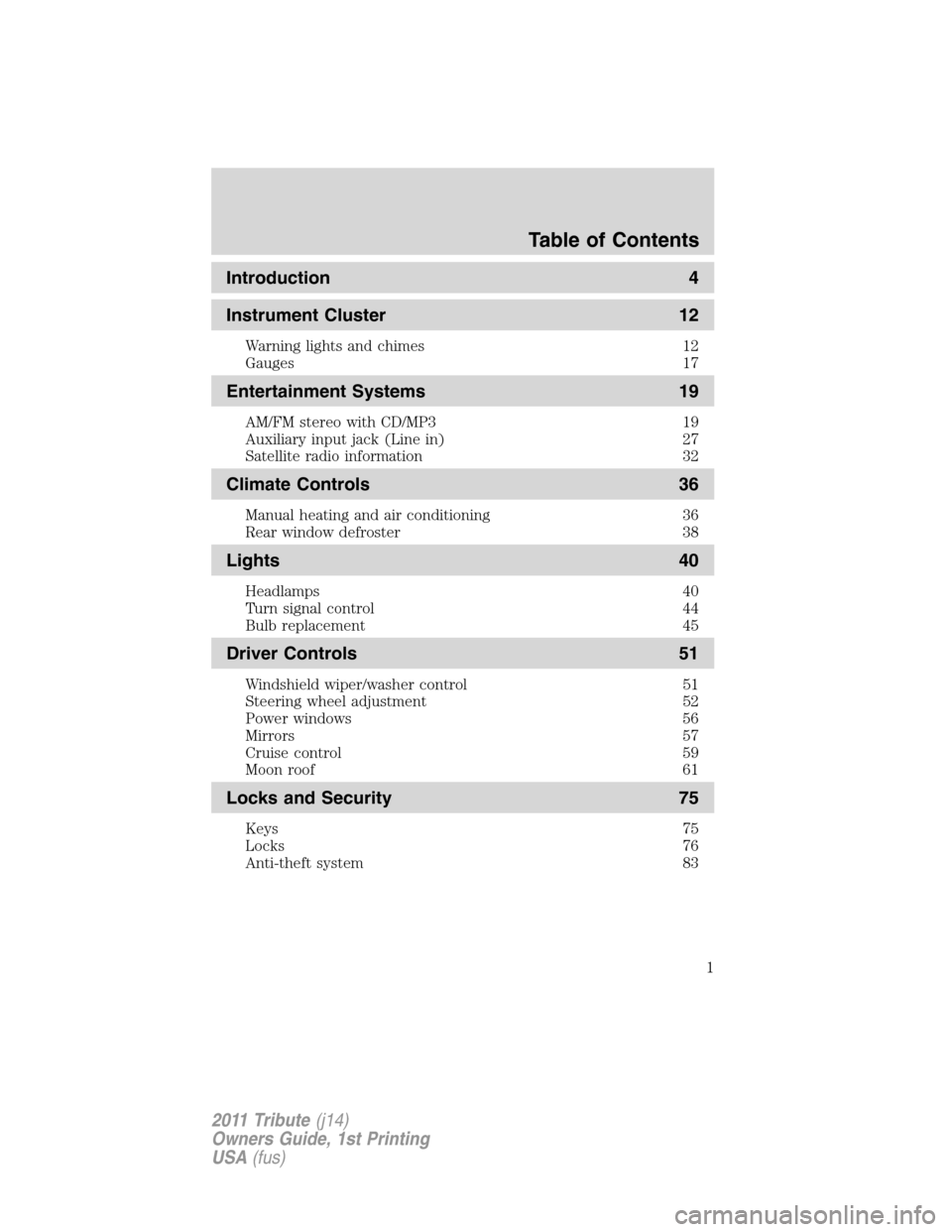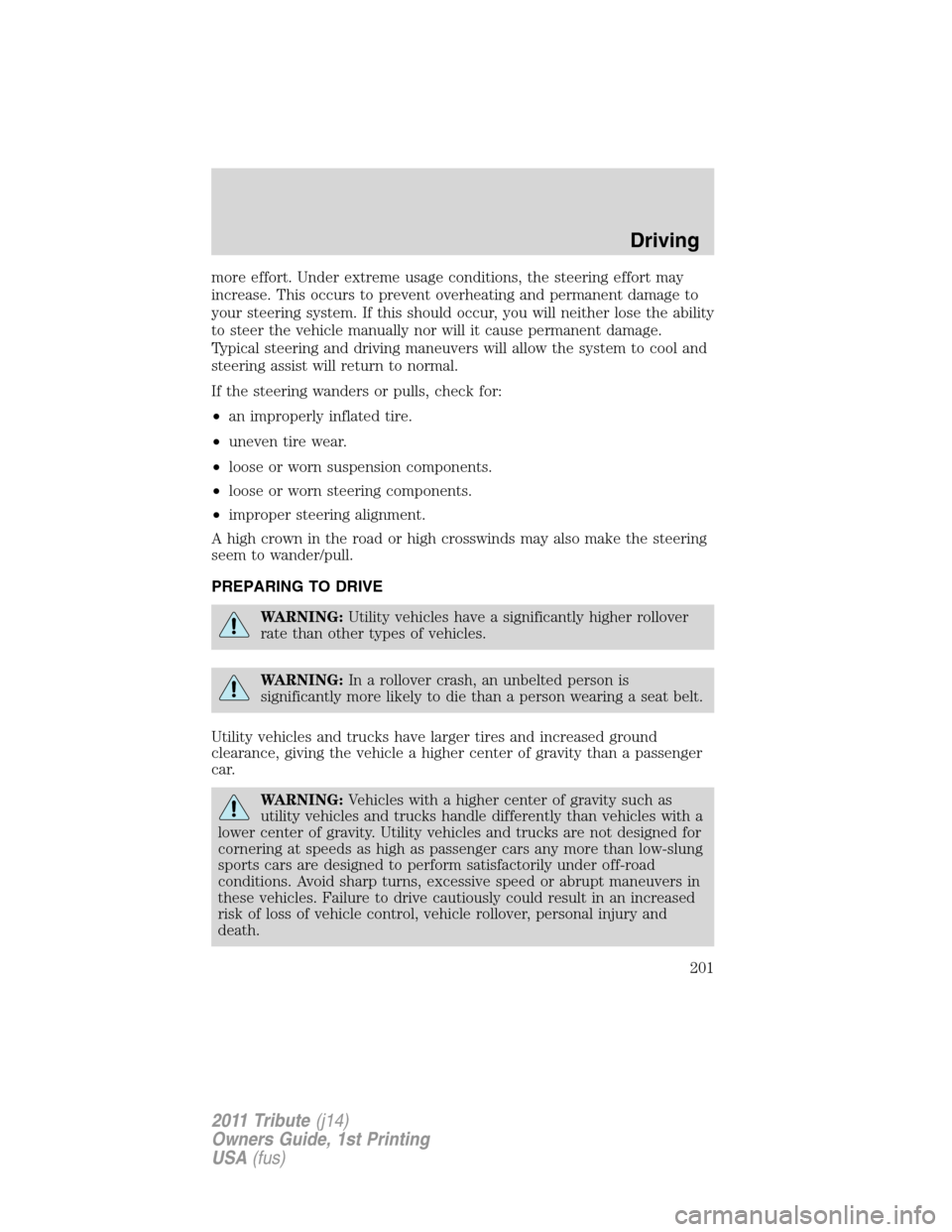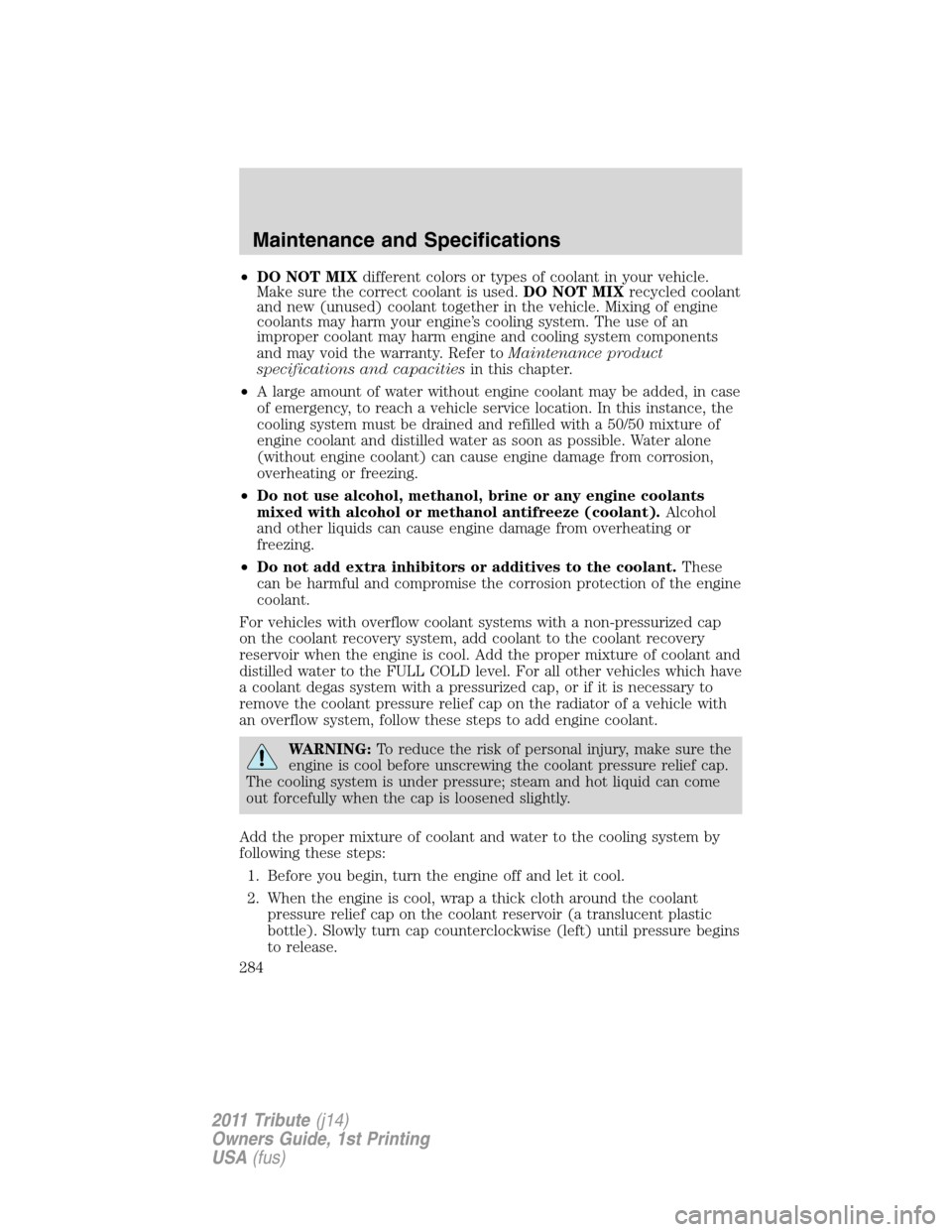heating MAZDA MODEL TRIBUTE 2011 Owners Manual (in English)
[x] Cancel search | Manufacturer: MAZDA, Model Year: 2011, Model line: MODEL TRIBUTE, Model: MAZDA MODEL TRIBUTE 2011Pages: 320, PDF Size: 2.08 MB
Page 1 of 320

Introduction 4
Instrument Cluster 12
Warning lights and chimes 12
Gauges 17
Entertainment Systems 19
AM/FM stereo with CD/MP3 19
Auxiliary input jack (Line in) 27
Satellite radio information 32
Climate Controls 36
Manual heating and air conditioning 36
Rear window defroster 38
Lights 40
Headlamps 40
Turn signal control 44
Bulb replacement 45
Driver Controls 51
Windshield wiper/washer control 51
Steering wheel adjustment 52
Power windows 56
Mirrors 57
Cruise control 59
Moon roof 61
Locks and Security 75
Keys 75
Locks 76
Anti-theft system 83
Table of Contents
1
2011 Tribute(j14)
Owners Guide, 1st Printing
USA(fus)
Page 2 of 320

Seating and Safety Restraints 87
Seating 87
Safety restraints 99
Airbags 114
Child restraints 131
Tires, Wheels and Loading 149
Tire information 151
Tire inflation 154
Tire Pressure Monitoring System (TPMS) 167
Vehicle loading 172
Trailer towing 180
Recreational towing 184
Driving 186
Starting 186
Brakes 193
Electronic stability control 195
Transmission operation 203
Rear-view camera system 208
Roadside Emergencies 218
Hazard flasher control 218
Fuel pump shut-off switch 218
Fuses and relays 219
Changing tires 226
Wheel lug nut torque 236
Overheating 237
Jump starting 238
Wrecker towing 242
Customer Assistance 244
Reporting safety defects (U.S. only) 256
Reporting safety defects (Canada only) 257
Cleaning 258
Table of Contents
2
2011 Tribute(j14)
Owners Guide, 1st Printing
USA(fus)
Page 17 of 320

GAUGES
Shown in standard measure. Metric similar.
Speedometer:Indicates the
current vehicle speed.
Engine coolant temperature
gauge:Indicates engine coolant
temperature. At normal operating
temperature, the needle will be in
the normal range (between “H” and
“C”).If it enters the red section,
the engine is overheating. Stop
the vehicle as soon as safely
possible, switch off the engine and let the engine cool.
60
100x1000/min4
0 123
5
6
7
8
km/h
00 20406080
120
140
160
180
200
2040
80
100
120
mph
EFC
H
Instrument Cluster
17
2011 Tribute(j14)
Owners Guide, 1st Printing
USA(fus)
Page 36 of 320

MANUAL HEATING AND AIR CONDITIONING SYSTEM
1.
Fan speed adjustment:Turn to select fan speed.
2.
RRear defroster:Press to activate/deactivate the rear window
defroster. Refer toRear window defrosterlater in this chapter for
more information.
3.
Defrost:Distributes outside air through the windshield
defroster vents and demister vents. Can be used to clear the
windshield of fog and thin ice. The system will automatically provide
outside air to reduce window fogging. Press this button again to
return to the previous air flow selection.
4.
:Distributes air through the windshield defroster vents,
demister vents, floor vents and rear seat floor vents. The system will
automatically provide outside air to reduce window fogging.
5.
Power:Press to activate/deactivate the climate control system.
When the system is off, outside air is prevented from entering the
vehicle through the vents.
6.
:Distributes air through the instrument panel vents.
7.
:Distributes air through the instrument panel vents, demister
vents, floor vents and rear seat floor vents (if equipped).
8.
:Distributes air through the demister vents, floor vents and rear
seat floor vents (if equipped).
9.Temperature control:Controls the temperature of the airflow in
the vehicle.
Climate Controls
36
2011 Tribute(j14)
Owners Guide, 1st Printing
USA(fus)
Page 93 of 320

Heated seats (if equipped)
WARNING:Persons who are unable to feel pain to the skin
because of advanced age, chronic illness, diabetes, spinal cord
injury, medication, alcohol use, exhaustion, or other physical
conditions, must exercise care when using the seat heater. The seat
heater may cause burns even at low temperatures, especially if used
for long periods of time. Do not place anything on the seat that
insulates against heat, such as a blanket or cushion, because this may
cause the seat heater to overheat. Do not puncture the seat with pins,
needles, or other pointed objects because this may damage the heating
element which may cause the seat heater to overheat. An overheated
seat may cause serious personal injury.
Note:Do not do the following:
•Place heavy objects on the seat
•Operate the seat heater if water or any other liquid is spilled on the
seat. Allow the seat to dry thoroughly.
To operate the heated seats:
•Press the button located on the
instrument panel to activate.
•Press again to deactivate.
The heated seats will activate when the ignition is in the on position and
the engine is running.
REAR SEATS
Second row adjustable head restraints
Your vehicle is equipped with second row outboard and center head
restraints that are vertically adjustable.
WARNING:To minimize the risk of neck injury in the event of a
crash, the driver and passenger occupants should not sit in
and/or operate the vehicle, until the head restraint is placed in its
proper position. The driver should never adjust the head restraint
while the vehicle is in motion.
Seating and Safety Restraints
93
2011 Tribute(j14)
Owners Guide, 1st Printing
USA(fus)
Page 191 of 320

Important ventilating information
If the engine is idling while the vehicle is stopped in an open area for
long periods of time, open the windows at least 1 inch (2.5 cm).
Adjust the heating or air conditioning (if equipped) to bring in fresh air.
Note:Improve vehicle ventilation by
keeping all air inlet vents clear of
snow, leaves and other debris.
ENGINE BLOCK HEATER (IF EQUIPPED)
An engine block heater warms the engine coolant which aids in starting
and allows the heater/defroster system to respond quickly. If your vehicle
is equipped with this system, your equipment includes a heater element
which is installed in your engine block and a wire harness which allows
the user to connect the system to a grounded 120 volt A/C electrical
source. The block heater system is most effective when outdoor
temperatures reach below 0°F (-18°C).
WARNING:Failure to follow engine block heater instructions
could result in property damage or physical injury.
WARNING:To reduce the risk of electrical shock, do not use
your heater with ungrounded electrical systems or two-pronged
(cheater) adapters.
Prior to using the engine block heater, follow these recommendations for
proper and safe operation:
•For your safety, use an outdoor extension cord that is product
certified by Underwriter’s Laboratory (UL) or Canadian Standards
Association (CSA). Use only an extension cord that can be used
outdoors, in cold temperatures, and is clearly marked “Suitable for Use
with Outdoor Appliances.” Never use an indoor extension cord
outdoors; it could result in an electric shock or fire hazard.
•Use a 16-gauge outdoor extension cord, minimum.
Driving
191
2011 Tribute(j14)
Owners Guide, 1st Printing
USA(fus)
Page 201 of 320

more effort. Under extreme usage conditions, the steering effort may
increase. This occurs to prevent overheating and permanent damage to
your steering system. If this should occur, you will neither lose the ability
to steer the vehicle manually nor will it cause permanent damage.
Typical steering and driving maneuvers will allow the system to cool and
steering assist will return to normal.
If the steering wanders or pulls, check for:
•an improperly inflated tire.
•uneven tire wear.
•loose or worn suspension components.
•loose or worn steering components.
•improper steering alignment.
A high crown in the road or high crosswinds may also make the steering
seem to wander/pull.
PREPARING TO DRIVE
WARNING:Utility vehicles have a significantly higher rollover
rate than other types of vehicles.
WARNING:In a rollover crash, an unbelted person is
significantly more likely to die than a person wearing a seat belt.
Utility vehicles and trucks have larger tires and increased ground
clearance, giving the vehicle a higher center of gravity than a passenger
car.
WARNING:Vehicles with a higher center of gravity such as
utility vehicles and trucks handle differently than vehicles with a
lower center of gravity. Utility vehicles and trucks are not designed for
cornering at speeds as high as passenger cars any more than low-slung
sports cars are designed to perform satisfactorily under off-road
conditions. Avoid sharp turns, excessive speed or abrupt maneuvers in
these vehicles. Failure to drive cautiously could result in an increased
risk of loss of vehicle control, vehicle rollover, personal injury and
death.
Driving
201
2011 Tribute(j14)
Owners Guide, 1st Printing
USA(fus)
Page 215 of 320

Descend a hill in the same gear you
would use to climb up the hill to
avoid excessive brake application
and brake overheating. Do not
descend in neutral; instead,
disengage overdrive or manually
shift to a lower gear. When
descending a steep hill, avoid
sudden hard braking as you could
lose control. When you brake hard,
the front wheels can’t turn and if
they aren’t turning, you won’t be
able to steer. The front wheels have to be turning in order to steer the
vehicle.
Since your vehicle has anti-lock brakes, apply the brakes steadily. Do not
“pump” the brakes.
Driving on snow and ice
•4WD vehicles have advantages over 2WD vehicles in snow and ice but
can skid like any other vehicle.
•Should you start to slide while driving on snowy or icy roads, turn the
steering wheel in the direction of the slide until you regain control.
•Avoid sudden applications of power and quick changes of direction on
snow and ice. Apply the accelerator slowly and steadily when starting
from a full stop.
•Avoid sudden braking as well. Although a 4WD vehicle may accelerate
better than a two-wheel drive vehicle in snow and ice, it won’t stop
any faster, because as in other vehicles, braking occurs at all four
wheels. Do not become overconfident as to road conditions.
•Make sure you allow sufficient distance between you and other
vehicles for stopping. Drive slower than usual and consider using one
of the lower gears. In emergency stopping situations, avoid locking of
the wheels. Use a “squeeze” technique, push on the brake pedal with a
steadily increasing force which allows the wheels to brake yet
continue to roll so that you may steer in the direction you want to
travel. If you lock the wheels, release the brake pedal and repeat the
squeeze technique. Since your vehicle is equipped with a Four Wheel
Anti-Lock Brake System (ABS), apply the brake steadily. Do not
“pump” the brakes. Refer to theBrakessection of this chapter for
additional information on the operation of the anti-lock brake system.
Driving
215
2011 Tribute(j14)
Owners Guide, 1st Printing
USA(fus)
Page 237 of 320

Note:Inspect the wheel pilot hole
prior to installation. If there is
visible corrosion in wheel pilot hole,
remove loose particles by wiping
with clean rag and apply grease.
Apply grease only to the wheel pilot
hole surface by smearing a “dime”
(1 square cm) sized glob of grease
around the wheel pilot surface (1)
with end of finger. DO NOT apply
grease to lugnut/stud holes or
wheel-to-brake surfaces.
OVERHEATING
If the temperature gauge indicates overheating and you experience
power loss, you hear a loud knocking or pinging noise, the engine is
probably too hot.
If this happens:
1. Drive safely to the side of the road and park off the right-of-way.
2. Shift the automatic transmission into P (Park) or the manual
transmission into the neutral position, and apply the parking brake.
3. Turn off the air conditioner.
WARNING:Steam from an overheated engine is dangerous. The
escaping steam could seriously burn you. Open the hood ONLY
after steam is no longer escaping from the engine.
4. Check whether coolant or steam is escaping from under the hood or
from the engine compartment.
•If steam is coming from the engine compartment:do not go near
the front of the vehicle. Stop the engine, then turn the ignition switch
to the on position without starting the engine. The radiator cooling
fans will start to cool the engine.
•If neither coolant nor steam is escaping:open the hood and idle
the engine until it cools. If this does not lower the temperature, stop
the engine and let it cool.
5. Check the coolant level. If it is low, look for leaks in the radiator
hoses and connections, heater hoses and connections, radiator and
water pump.
If you find a leak or other damage, or if coolant is still leaking, stop the
engine and call an authorized dealer.
Roadside Emergencies
237
2011 Tribute(j14)
Owners Guide, 1st Printing
USA(fus)
Page 284 of 320

•DO NOT MIXdifferent colors or types of coolant in your vehicle.
Make sure the correct coolant is used.DO NOT MIXrecycled coolant
and new (unused) coolant together in the vehicle. Mixing of engine
coolants may harm your engine’s cooling system. The use of an
improper coolant may harm engine and cooling system components
and may void the warranty. Refer toMaintenance product
specifications and capacitiesin this chapter.
•A large amount of water without engine coolant may be added, in case
of emergency, to reach a vehicle service location. In this instance, the
cooling system must be drained and refilled with a 50/50 mixture of
engine coolant and distilled water as soon as possible. Water alone
(without engine coolant) can cause engine damage from corrosion,
overheating or freezing.
•Do not use alcohol, methanol, brine or any engine coolants
mixed with alcohol or methanol antifreeze (coolant).Alcohol
and other liquids can cause engine damage from overheating or
freezing.
•Do not add extra inhibitors or additives to the coolant.These
can be harmful and compromise the corrosion protection of the engine
coolant.
For vehicles with overflow coolant systems with a non-pressurized cap
on the coolant recovery system, add coolant to the coolant recovery
reservoir when the engine is cool. Add the proper mixture of coolant and
distilled water to the FULL COLD level. For all other vehicles which have
a coolant degas system with a pressurized cap, or if it is necessary to
remove the coolant pressure relief cap on the radiator of a vehicle with
an overflow system, follow these steps to add engine coolant.
WARNING:To reduce the risk of personal injury, make sure the
engine is cool before unscrewing the coolant pressure relief cap.
The cooling system is under pressure; steam and hot liquid can come
out forcefully when the cap is loosened slightly.
Add the proper mixture of coolant and water to the cooling system by
following these steps:
1. Before you begin, turn the engine off and let it cool.
2. When the engine is cool, wrap a thick cloth around the coolant
pressure relief cap on the coolant reservoir (a translucent plastic
bottle). Slowly turn cap counterclockwise (left) until pressure begins
to release.
Maintenance and Specifications
284
2011 Tribute(j14)
Owners Guide, 1st Printing
USA(fus)